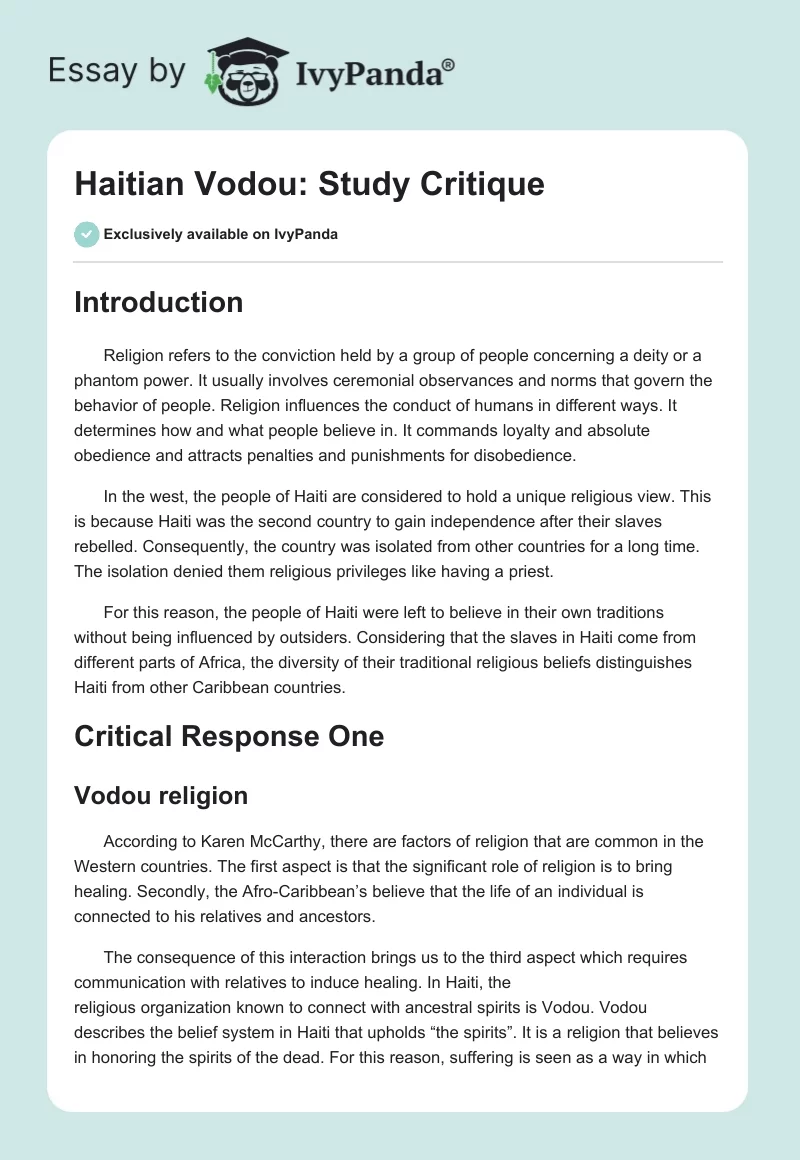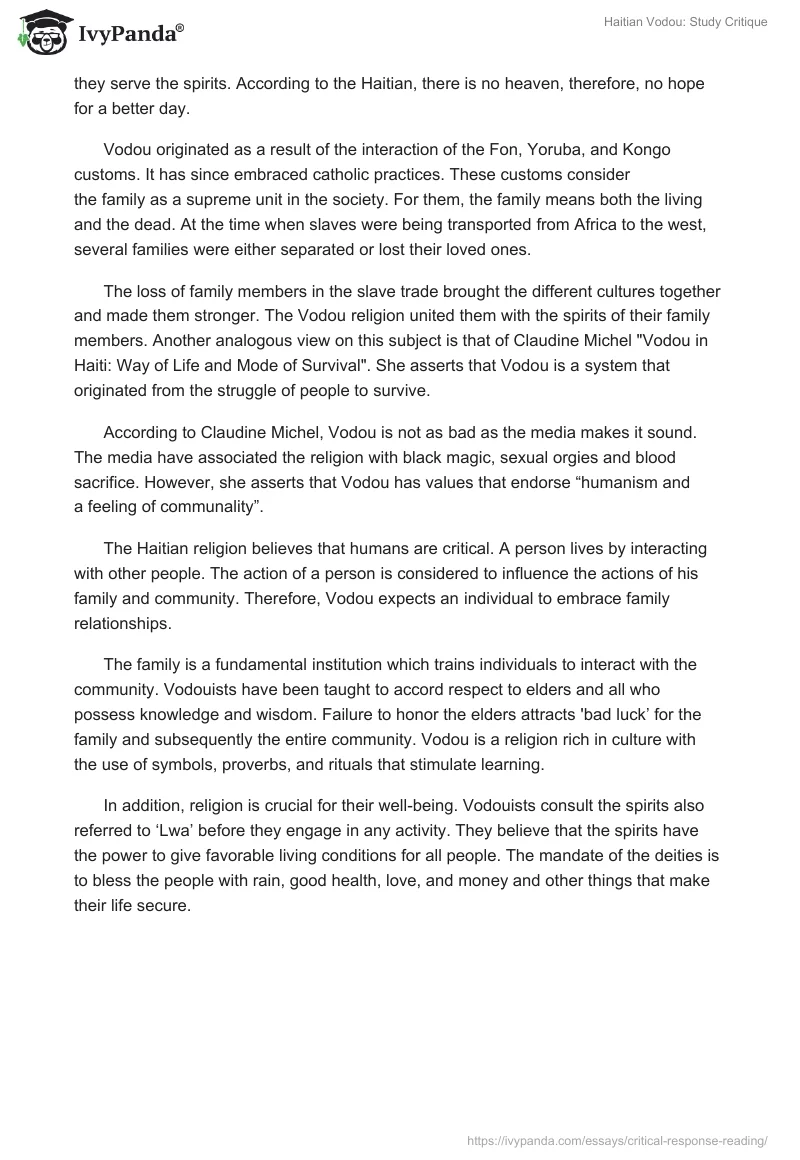Introduction
Religion refers to the conviction held by a group of people concerning a deity or a phantom power. It usually involves ceremonial observances and norms that govern the behavior of people. Religion influences the conduct of humans in different ways. It determines how and what people believe in. It commands loyalty and absolute obedience and attracts penalties and punishments for disobedience.
In the west, the people of Haiti are considered to hold a unique religious view. This is because Haiti was the second country to gain independence after their slaves rebelled. Consequently, the country was isolated from other countries for a long time. The isolation denied them religious privileges like having a priest.
For this reason, the people of Haiti were left to believe in their own traditions without being influenced by outsiders. Considering that the slaves in Haiti come from different parts of Africa, the diversity of their traditional religious beliefs distinguishes Haiti from other Caribbean countries.
Critical Response One: Vodou religion
According to Karen McCarthy, there are factors of religion that are common in the Western countries. The first aspect is that the significant role of religion is to bring healing. Secondly, the Afro-Caribbean’s believe that the life of an individual is connected to his relatives and ancestors.
The consequence of this interaction brings us to the third aspect which requires communication with relatives to induce healing. In Haiti, the religious organization known to connect with ancestral spirits is Vodou. Vodou describes the belief system in Haiti that upholds “the spirits”. It is a religion that believes in honoring the spirits of the dead. For this reason, suffering is seen as a way in which they serve the spirits. According to the Haitian, there is no heaven, therefore, no hope for a better day.
Vodou originated as a result of the interaction of the Fon, Yoruba, and Kongo customs. It has since embraced catholic practices. These customs consider the family as a supreme unit in the society. For them, the family means both the living and the dead. At the time when slaves were being transported from Africa to the west, several families were either separated or lost their loved ones.
The loss of family members in the slave trade brought the different cultures together and made them stronger. The Vodou religion united them with the spirits of their family members. Another analogous view on this subject is that of Claudine Michel “Vodou in Haiti: Way of Life and Mode of Survival”. She asserts that Vodou is a system that originated from the struggle of people to survive.
According to Claudine Michel, Vodou is not as bad as the media makes it sound. The media have associated the religion with black magic, sexual orgies and blood sacrifice. However, she asserts that Vodou has values that endorse “humanism and a feeling of communality”.
The Haitian religion believes that humans are critical. A person lives by interacting with other people. The action of a person is considered to influence the actions of his family and community. Therefore, Vodou expects an individual to embrace family relationships.
The family is a fundamental institution which trains individuals to interact with the community. Vodouists have been taught to accord respect to elders and all who possess knowledge and wisdom. Failure to honor the elders attracts ‘bad luck’ for the family and subsequently the entire community. Vodou is a religion rich in culture with the use of symbols, proverbs, and rituals that stimulate learning.
In addition, religion is crucial for their well-being. Vodouists consult the spirits also referred to ‘Lwa’ before they engage in any activity. They believe that the spirits have the power to give favorable living conditions for all people. The mandate of the deities is to bless the people with rain, good health, love, and money and other things that make their life secure.
Critical Response Two: Vodou and art
In “Rara of the universe”, the author claims that Vodou has promoted a distinguished tradition of consecrated art. The remarkable philosophy of art can be attributed to the blending of different religions from Africa. One of the dominant influences of Haitian art is the Dahomey religion.
It originated from Dahomean coast, which was once, a base for slave trade. Later, the religion borrowed and assimilated the religion of the Yoruba and the Kongo. The people of Dahomey believe in a war deity referred to as ‘Gu’. ‘Gu’ is said to be the characterization of the sharp blade in a razor, a machete or a spear.
The image of ‘Gu’s’ blade of this deity is represented as a monument of iron. The image comprises small blades, arrows, poppers and other sharp objects. The image of ‘Gu’ demonstrates his immense power and influence. Additionally, the Dahomean has another deity of war symbolizing praise. Its image is of a lion with pointed fangs engraved in wood. The pointed fangs of the lion were meant to post a message of terror to the world.
When the black people first came to Haiti as slaves, their slave masters who were Roman Catholics imposed their religion on them. They would baptize them by force and provide them with carvings and lithographs of the Catholic saints. Although these images were given to honor the saints, the black people compared the characteristics of the saints to their own deities. For that reason, the symbol of the saints was associated with the god of war ‘Gu’.
The iron sword used in war by Saint James was agreed to be the epitome of a warrior deity ‘Ogun Ferraille’, while the flags were compared to ‘gubasa,’ a symbol of the battle in Dahomey. The weapons and flags seen on the catholic lithographs brought new meaning to the Afro-Haitian culture. Each time a person was haunted by the spirit of ‘Ogun Ferraille’ they had to dance around the altar. They did this with a heated iron bar or staff in his hands to prove the spirit was authentic.
The other type of sacred art commonly found amongst the Vodou followers is the vodun flags. Flags are used to commemorate ceremonies and rituals in Vodou. Anytime flags are raised they usher in the spirit of the deity associated with ceremony in context.
Flags mark the border line between the physical and the spiritual world. It is a way of honoring or greeting the spirits. Flags are brought out in a traditional way. Tradition demands that a flag can only be brought out of the sanctuary by a party consisting of two women with a man carrying a sword.
While the party brings out the flag, the people witnessing the process can be moved to sing in praise of the deity of thunder whose nature is like the thud of guns heard during the war. The symbols of the deities are designed with beads on the flags. Beads are believed to possess spirits. The beads used sparkle with different attributes of the deities. For example, the flag representing the deities of the skies is made from a pastel blue silk material with several silver glitters.
Additionally, Vodou deities are sometimes traced on the ground using a powdery substance mostly made from cornmeal. The paintings are known as ‘Veve’. The patterns were derived from a fusion of Fon and Kongo ground designs. The ground drawing extol, beckon and incarnate the vodou deities at the same time.
One of the most beautiful ground signs was borrowed from the tribe of Tu- Chokwe in Angola. The drawing is a collection of a variety of different motifs. It has a symbol that portrays the realm of the deity at the top while the earth is depicted directly opposite. At the center, a nucleated pastille model represents the ‘muyombo’ tree which is believed to be sacred.
Critical Response Three: Vodou Artists
Hector Hyppolite
Selden Rodman in his article A visit with Hector Hyppolite describes Hector Hyppolite as a key painter in the history of Haiti. His grandfather and father were priests, but he felt as he was more of a painter; so he asked the spirit’s consent to suspend his priestly duties for some time. He is not legally married. Because, he believes his grandfather betrothed him to the goddess ‘La Sirene’ while he was still young. ‘La Sirene’ is responsible for his finances.
However, he keeps mistresses who in his opinion should consider themselves lucky. Hector’s life revolves around painting. When he is not painting, he takes part in Vodou rituals. The Vodou altar in his house is usually full of sacrifices for the spirits. Nevertheless, his inspiration for painting is Saint John the Baptist. Hector’s relationship with Saint John and ‘La Sirene’ demonstrates the confluence of Catholicism on the Vodou religion.
Andre Pierre
Andre Pierre is another notable Haitian artist. His thoughts about Vodou are captured by Donald Cosentino in his work A world created by Magic. Andre Pierre believes that Vodou was the first religion that ever existed. Vodou is responsible for creation through magic. He considers that human beings are the result of magic therefore; they live with the spirits.
Vodou is superior to other religions because it embraces nature and studies the actions of people. His work of art is inspired by the need to show the world that Vodou is not a diabolical religion. He portrays Vodou as a religion that promotes fairness and neighborly love. On the other hand, he claims that Vodou promotes war.
Edouard Duval- Carrie
In his other article, Divine Revolution, the Art of Edouard Duval- Carrie Donald Cosentino describes the painting of the Duval – Carrier. Although their paintings are ages apart, the work of Edouard is similar to that of Andre-Pierre with his mythical style. Nevertheless, Edouard’s paintings and monuments are rich in Haitian History. He is known for painting the revolution and the fight for independence.
He has erected altars as an attribute to the heroes of the revolution such as Toussaint Louverture. Furthermore, he has tried to paint pictures of the ‘lwa’ of the Vodou religion. Since the ‘lwa’ represents the ancestors, Edouard’s work shows how the ‘lwa’ would look like at the present time. According to Donald Cosentino, Edouard plans to construct a Vodou temple where he can transform his paintings and sculptures into monumental spaces.
Amateur painters
Haiti has one of the most remarkable pieces of art. The first art center was started in May, 1944. During the launch, paintings and other works of art from different artists were displayed. Months later, an amateur artist sent his work of primitive art at the center. The piece of art opened the door for this artist and others to showcase their talent.
It is through the art center that artist like Hector Hyppolite were recognized. His paintings would later alter the art in Haiti. Through the Centre, easel and mural paintings are now well established in Haiti. Other types of art-like sculptures ceramics are yet to catch up.
Bibliography
Brown, McCarthy Karen. Afro-Caribbean: A Haitian Case Study. New York: Palgrave Macmillan, 2007
Claudine, Michel and Bellegrade-Smith Patrick. Vodou in Haitian life and Culture. New York: Palgrave Macmillan, 2007
Cosentino, Donald. Divine Revolution: the art of Edouard Duval-Carrié. California:UCLA Fowler Museum of Cultural History, 2004
Hoffman, G Larry. Haitian art: the legend and legacy of the naïve tradition.California: Davenport Art Gallery, 1985
Michel, Claudine. Vodou in Haiti: Way of Life and Mode of Survival. New York: Palgrave Macmillan, 2007
Passalacqua, Sue and Cervantes Joseph. Understanding gender and Culture within the Context of Spirituality. Fullerton: California State University, 2003.
Selden, Rodman. Renaissance in Haiti: popular painters in the Black Republic. New York: Pellegrini & Cudahy, 1948
Thompson, Farris Robert. Flash of the spirit: African and Afro-American art and philosophy. New York: Vintage Books, 1984


